Food Blog SEO: Guide to Creating Recipes that Rank
Introduction to SEO for Food Blogs
After quitting my day job a couple of years ago, I decided to pursue one of my passions - food and nutrition blogging.
My decade of experience in web technology means I’m no stranger to SEO or search engine optimization. Just target the right keywords, have a reputable site, write good content, that’s all, right?
It turns out online recipe SEO has a few extra hoops to jump through. However, some of these hoops have the perk of really leveling out the playing field for newbies in the food blogging space. Test out your recipe SEO score here.
After running my site for just over a year, about a third of my recipes are ranked #1 or #2 for their target keywords. Thus, I wanted to share my tips and notes on SEO for recipes in an informative post.
This is a complete search engine optimization guide for food bloggers, collected from both my own experience and from SEO experts in the field. All of the resources and links are free to help you get started. Content is laid out in seven sections:
- Recipe Research and Target Keywords
- Basics of your Recipe Web Page
- Embrace Rich Data for Recipe SEO
- Machine Friendly Page Structure
- Search Engine Optimized Page Content
- Tune-up Recipe Page Performance
- Adopt a Recipe WordPress Plugin
Recipe Research and the Right Target Keywords
Thoughtfully creating content for your target audience, and focusing on what they are likely to search for is still the most important aspect of food blogging. Google summarized this idea as E-A-T (expertise, authority, and trustworthiness) in the context of SEO.
Your recipe should be fresh, differentiable, include and target long-tail keywords. It also helps to outline some common questions your viewers may have.
This section covers:
- Create some inspired recipes with trending food topics
- Embrace long-tail keywords for recipes
- Research keyword competitive landscape
- Outline common questions for your recipe’s keywords
Create some inspired recipes with trending food topics
Out of fresh ideas for a new recipe? Find a new food trend at exploding topics.
You can find less competitive food keywords that are also trending. This helps keep your new recipes fresh, and also ensures you have a stream of curious foodies looking for something adventurous. It also helps with search engine optimization for new food trends that are yet too competitive in terms of keywords.
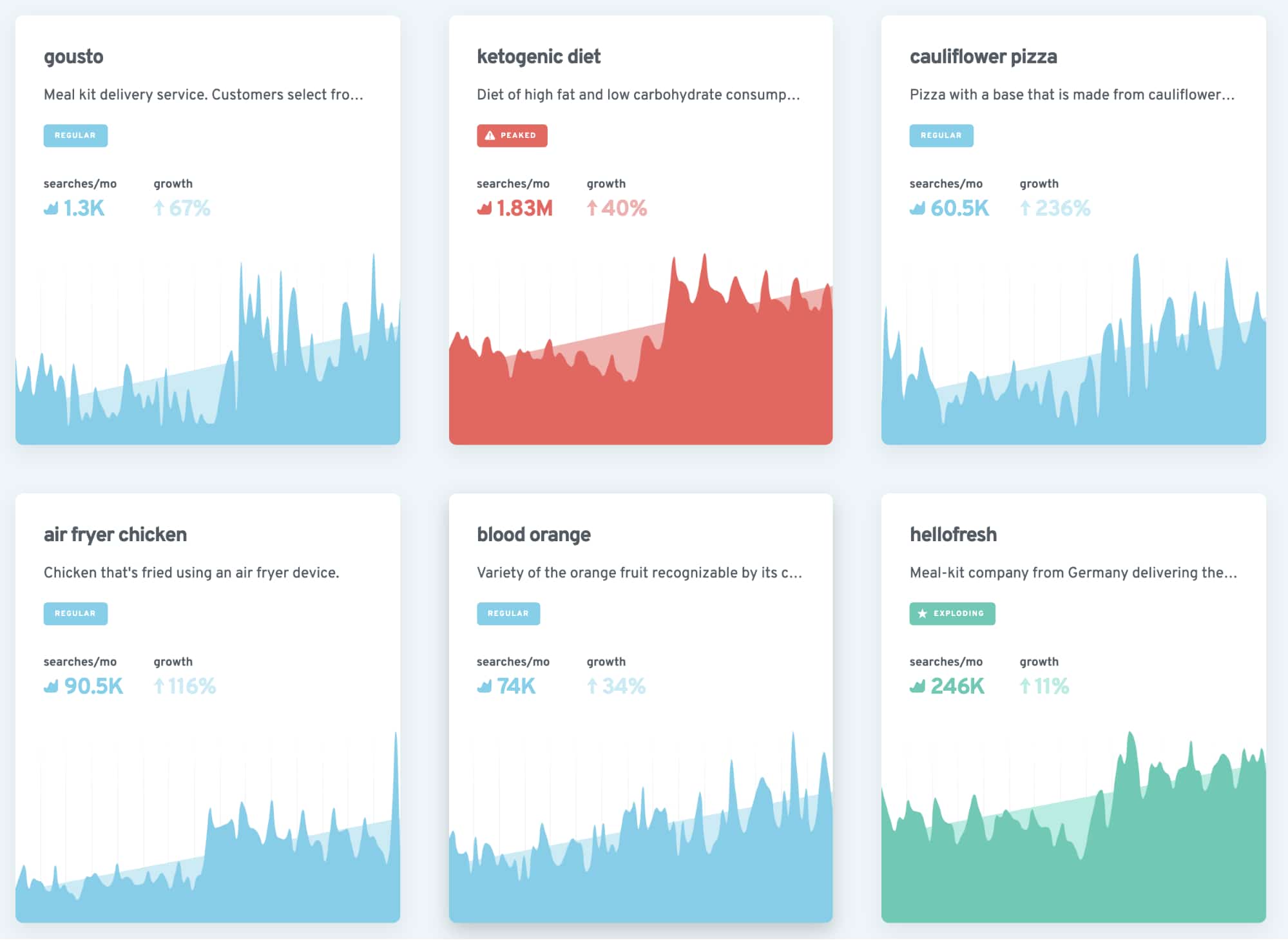
Embrace long-tail keywords for recipes
You can have the most amazing recipe for “strawberry cheesecake”, but it would be extremely tough to rank for the first page if you are just starting a food blog. It probably will not matter how well SEO optimized your recipe is.
For example, the first page of recipe cards on Google for “strawberry cheesecake” is full of exact matches from big names like Delish.com and Allrecipes.com that have hundreds of reviews.
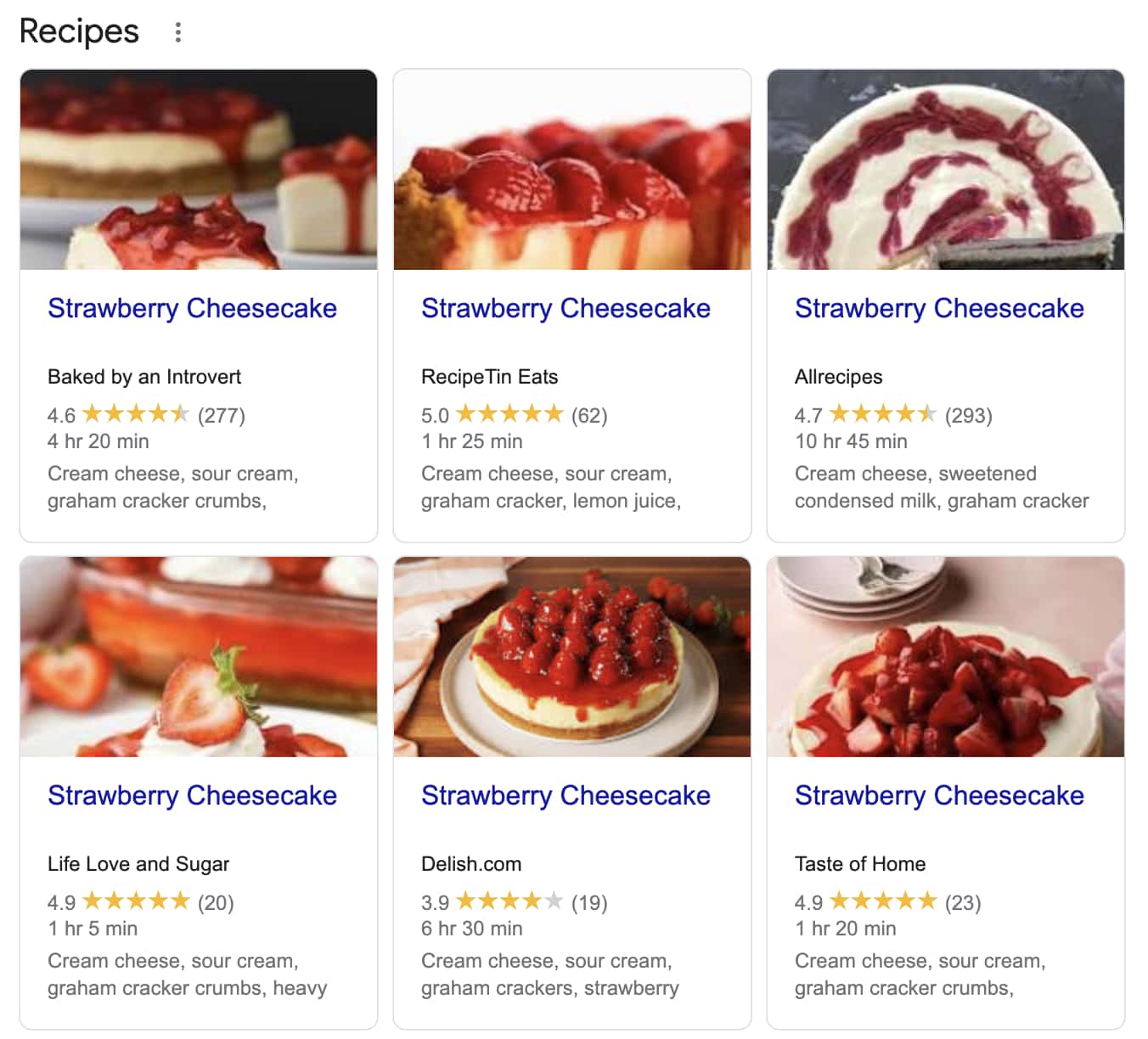
Using data science, we analyzed over 10 thousand recipes online to find patterns in existing recipes. We found that most cheesecake recipes have between 2 to 19 words in the name, with an average of about 4.5 words. This means that even established cheesecake recipes use multiple descriptors in the title to name their recipe, which can be considered long-tail keywords.
Ahref estimates that more than 90% of keywords people enter into search engines are long-tail keywords. Long-tail keywords also convert better, because they are usually more specific to the user’s needs.
So what can do you with your amazing strawberry cheesecake recipe?
You should figure out what differentiates your recipe from other cheesecake recipes.
Here are some ideas to differentiate your recipe from other similar recipes:
- How many ingredients does your recipe use compared to others?
- How fast is your recipe to make compared to similar recipes?
- Does your recipe have a unique ingredient or two?
- Does your recipe have special preparation steps? E.g. No-bake, one-pot, etc.
- Can your recipe follow a dietary restriction? E.g. Vegan, Gluten-free, etc.
- Does it provide special nutritional value? High protein, low fat, etc.
- Is it perfect for a special occasion? Halloween, Valentine’s day, etc.
Include what’s special about your strawberry cheesecake in the title. Jot down other ideas you have and include those in the keywords, description, and content. Cover your bases with all the long-tail keywords someone can find your unique recipe by.
Research keyword competitive landscape
Not researching the competitive landscape of your target keywords is like baking bread blinded-folded. There’s a small chance it might be a success, but not researching keyword competition probably will spell disaster for your recipe’s SEO.
Instead, use a tool like Ubersuggest, where you can find keyword suggestions. Also, you can see the traffic quantity and top competitors for your target keywords to gauge your competition.
Additionally, you can Google your target keywords in an incognito browser window to see which kinds of recipes currently rank.
Here are some good signs when studying the competition for your recipe’s target keywords:
- There are no exact matches for your keyword phrase in the top results.
- Most of the top matched recipes are not reviewed, and from lesser-known sites.
- The top results are poor matches for the intent of the keywords. For example, “low-fat vegan strawberry cheesecake” does not bring up low fat results
Outline common questions for your recipe’s keywords
While you are searching for competitors to your recipe, also take the time to jot down a few frequently asked questions regarding your dish.
One way is to look through the “People also ask” section in Google and see if you can provide a better answer to any of those questions. Providing a more direct or relevant answer to these questions could get your recipe featured in a snippet. Also, your viewers will likely find some of the answers helpful. You have longer, more meaningful content and more engaged users, which Google takes as a positive signal for SEO.
Here is an example list of questions around the cheesecake from Google:
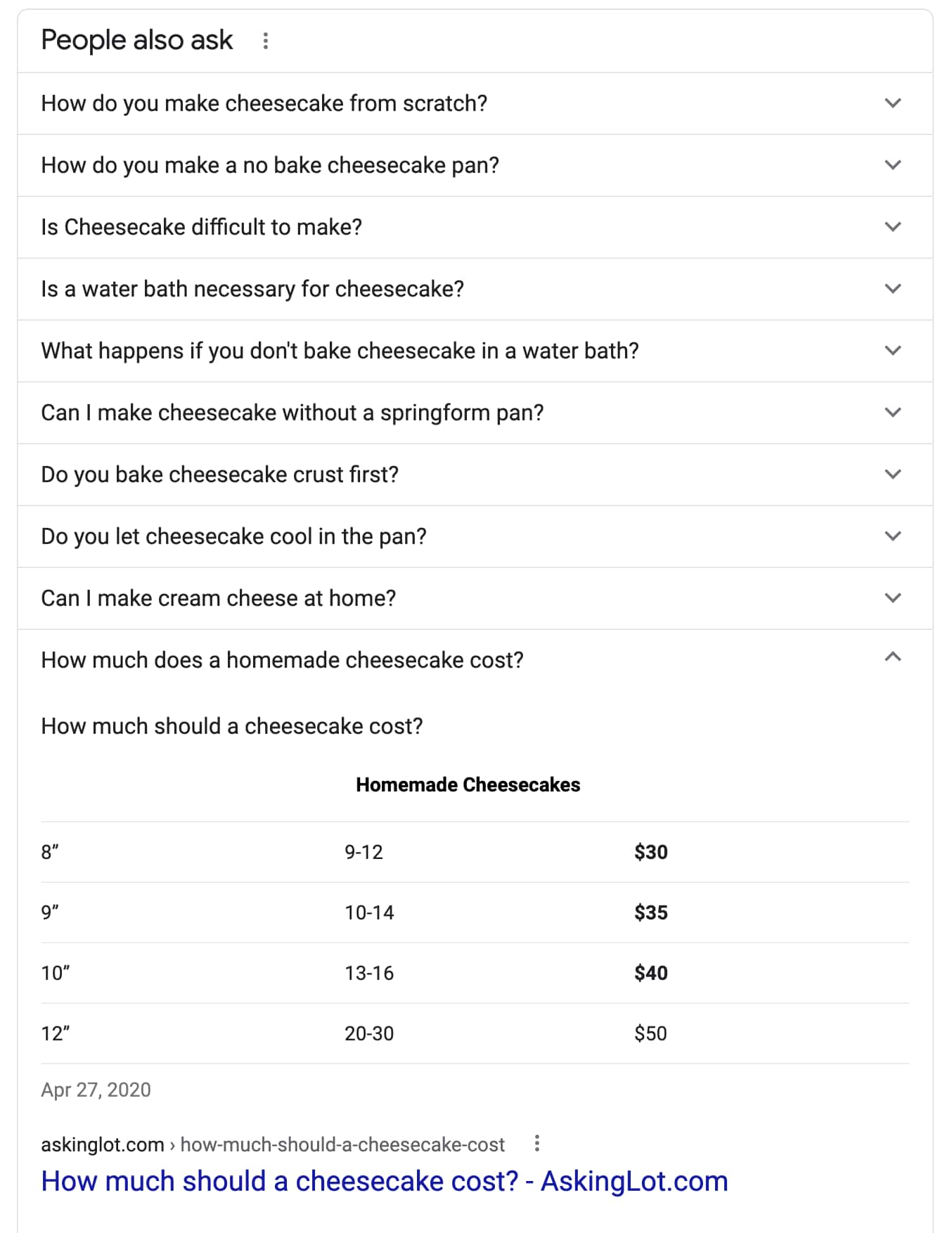
In the example above, the featured snippet does do a reasonable job of answering the question of how much a homemade cheesecake costs. However, we can likely create a better answer by adding the context of ingredients and ranges.
Some tips on choosing potential questions for your recipe FAQ section:
- Research what people ask.
- Consider how valuable the answer is to your reader.
- Evaluate how applicable your target keywords are to the question and answer.
- Brainstorm a few dimensions of your recipe to pose as questions.
- Storage
- Substitutions/availability of ingredients
- Nutrition
- Cost of recipe
Cover the Basics of your Recipe Web Page
Now that you settled on your target keywords and drafted your recipe, let’s deep dive into the absolute basics for the SEO of a recipe. If you are familiar with crafting titles, descriptions, canonical URLs, and site security, feel free to skip this section.
This section covers:
- Build your recipe page title for SEO
- Craft your recipe meta description
- Create a simple, SEO-friendly canonical URL
- Enable secure site and media
Build your recipe page title for SEO
The title tag is one of the most important pieces of information for your recipe's online identity and search engine optimization. You should always include a unique, concise, and descriptive title tag.
Your title tag should always include your exact target keywords for the recipe. Optionally, you can also include the name of your blog, separated by a “|” or “-”.
The title tag should neither be too long nor too short. Too long means your target keywords would be deemed less important in the phrase, and too short usually means highly competitive keywords. The ideal length is somewhere between 20 to 60 characters for your title.
Here are some real examples of well-developed titles for online recipes:
- Turkey Mushroom Tetrazzini Recipe | Taste of Home
- Quick Kimchi Pancakes Recipe | Bon Appetit
- Vegan Garlic Pasta | Minimalist Baker Recipes
Craft your recipe meta description
Your meta description tag will sometimes appear next to your recipe’s name in search results. Also, social platforms will often show the description as a summary of the recipe when shared.
Having a well-crafted meta description compels users to click through, and your recipe’s click-through rate does impact that page’s ability to rank [Moz, 2021].
You will want to add your target keywords in the description to reinforce your topic. Length also matters. Too short of a description will not provide enough information, but too long of a description could get cut off.
To make your description just right, it should be one long sentence or two shorter sentences. The ideal character length is between 80 to 320.
Here are some sample recipe meta descriptions that include their SEO target keywords:
- Your family will flip over this turkey and mushroom casserole. The creamy Parmesan-topped tetrazzini is so satisfying, no one will suspect it's lower in fat!
- These quick and easy kimchi pancakes come together in no time and are the perfect combination of crunchy and chewy.
- Easy, 30-minute creamy garlic pasta that's vegan and loaded with heart-healthy roasted tomatoes.
Create a simple, SEO-friendly canonical URL
The recipe link is another ranking factor for search engines on your target keywords. Your recipe URL should be short, simple, contain no dates and no extra subcategories.
Your URL, like your title and meta description, should include all of your target keywords. A best practice is to separate the words with “-”. The longer your URL, the less importance will be placed on your target keywords, so keep your recipe link nice and tidy.
Here are some examples of well-formed recipe URLs including their target keywords:
- https://www.tasteofhome.com/recipes/turkey-mushroom-tetrazzini
- https://simpleveganblog.com/simple-vegan-jambalaya/
- https://playswellwithbutter.com/lemony-basil-creamy-vegan-pasta/
Enable secure site and media
Google will penalize your site rank if your page or site is not running through an encrypted connection. This means that you have to enable HTTPS through WordPress or use a service like Cloudflare if you are self-hosting.
You should enforce HTTPS for all your images, internal links, and outbound links as well. Even if one of your linked images is insecure, viewers will see an insecure warning in their browser. Also, that image might not even be indexed or rank for image search.
Make sure all of your content is hosted and served securely.
Fully Embrace Rich Data for Recipe SEO
As an SEO perk specific to recipes, well-designed recipe rich data markup is instrumental in increasing your recipe’s organic traffic. Webnodes reports that websites saw increases of up to 30% in organic search-engine traffic using rich data or similar technologies.
Rich data mark-up also provides a consistent format for search engines to better understand your content. The more fields that are filled out correctly, the more potential ways your recipe can be featured in cards, galleries, or guided recipes.
This section covers:
- Qualify for Google Recipe Cards and Enhanced Recipes
- Meet the requirements for Guided Recipes
- Infuse creative recipe keywords for long-tail SEO
- Fold in recipe reviews for credibility
- Cook up a recipe video
Qualify for Google Recipe Cards and Enhanced Recipes
Having a small set of rich data (LD+Json) fields on your recipe qualifies you for Google Recipe cards and enhanced recipe search results. Without it, you will be losing a portion of the organic search traffic for your recipe.
Google places recipe cards on top of traditional recipe results. On mobile, recipe cards fill up 100% of the screen real estate for recipe searches.
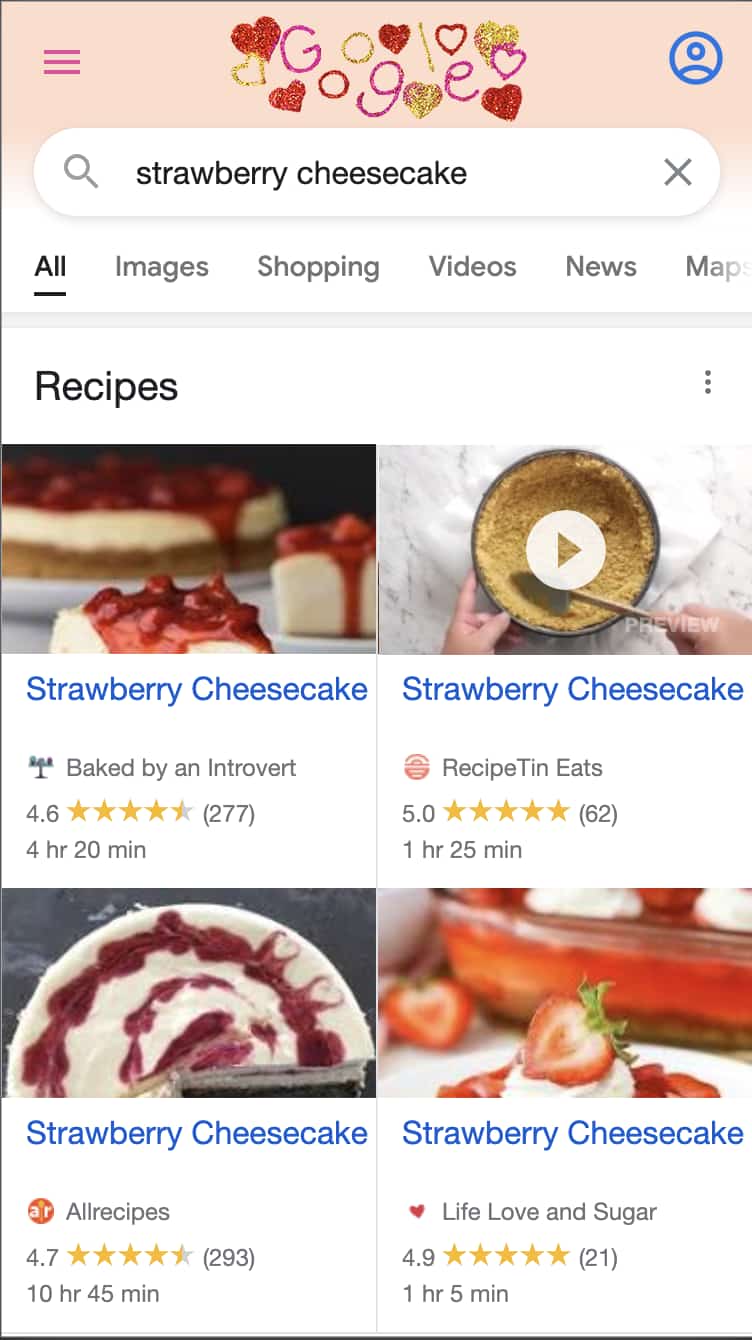
Also, enhanced recipe results offer a cover photo, reviews, and nutritional information for your viewers.
In the example below, Maangchi’s Japchae is an older, classic recipe, but other newer recipes can seem more credible with the rich data enhancements.
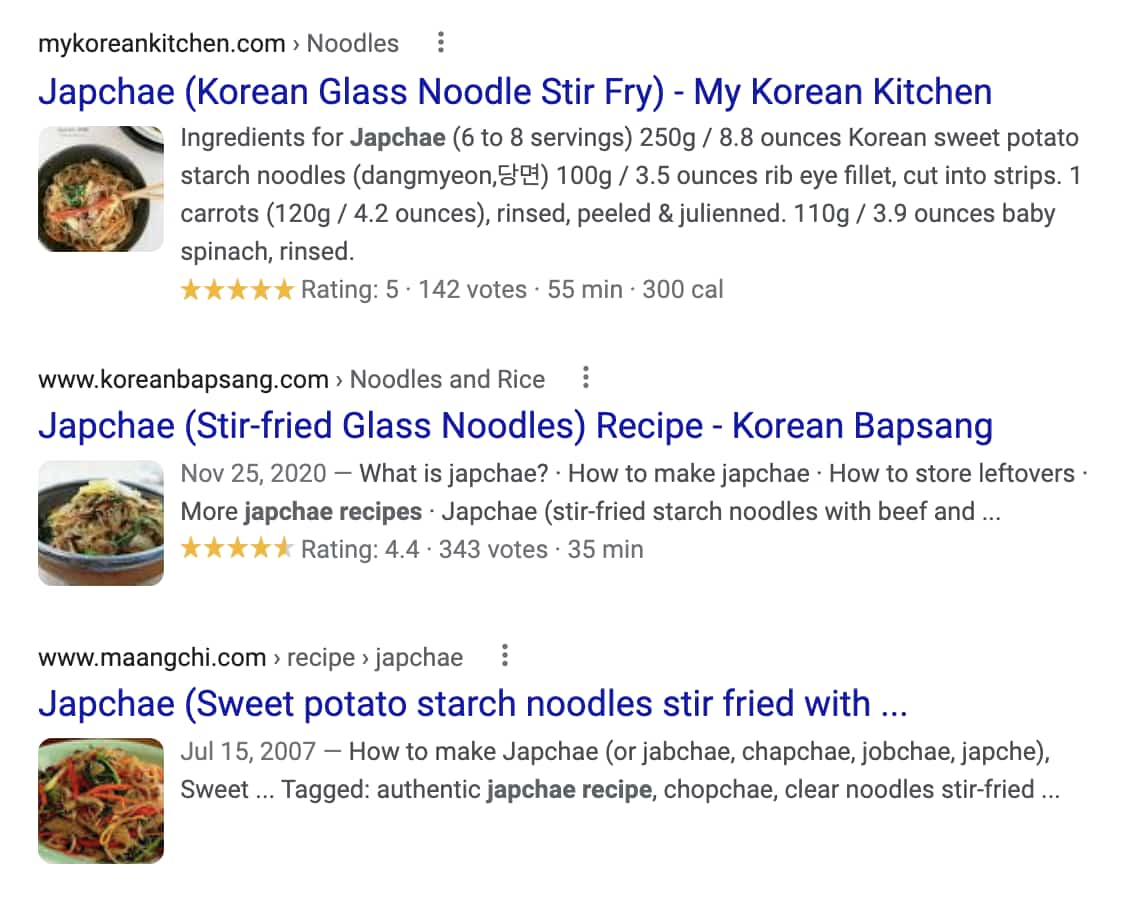
The only required fields for Google Recipe Card is a photo and the name of your recipe. However, most online recipes also fill out the author, total time, and average rating fields to create a compelling recipe card.
To add recipe rich data snippets, you can use a WordPress plugin, or build your ld+json from scratch.
Already have a recipe published? See which recipe rich data fields you are missing.
Meet the requirements for Guided Recipes
In addition to recipe cards, Google also offers Guided Recipes for Google Assistant. We know that voice search has been growing in popularity, and this feature could be a voice search application. As Google explains:
"[Google Guided Recipes] guides users through your recipes on Google Home and smart displays in a step-by-step manner."
Additional requirements for your rich data snippet include a list of recipe ingredients, a list of recipe instructions, and a whole number of servings for the recipe yield.
Infuse creative recipe keywords for long-tail SEO
The recipe keywords field from the rich data markup is an excellent location to use your long-tail keywords. There’s no limit to how many keywords you can include, but with all other fields, unique, descriptive, and concise is best.
Having analyzed hundreds of recipes online, we found that many recipes include only a couple of words, mostly rephrasing their target keywords. Some recipes include upwards of 60 keywords, also mostly variations of their original target keywords. Both these cases are not great use-cases of the keywords field.
Google suggests your keywords be descriptive, and creative:
"[The keywords field should include] other terms for your recipe such as the season (summer), the holiday (Halloween), or other descriptors (quick, easy, authentic)."
For example, if your strawberry cheesecake recipe has a special crust, adding “walnut cinnamon crust cheesecake” in your keywords could help capture long-tail keyword searches.
Fold in recipe reviews for credibility
If you saw these two recipes, which one would you click on first?
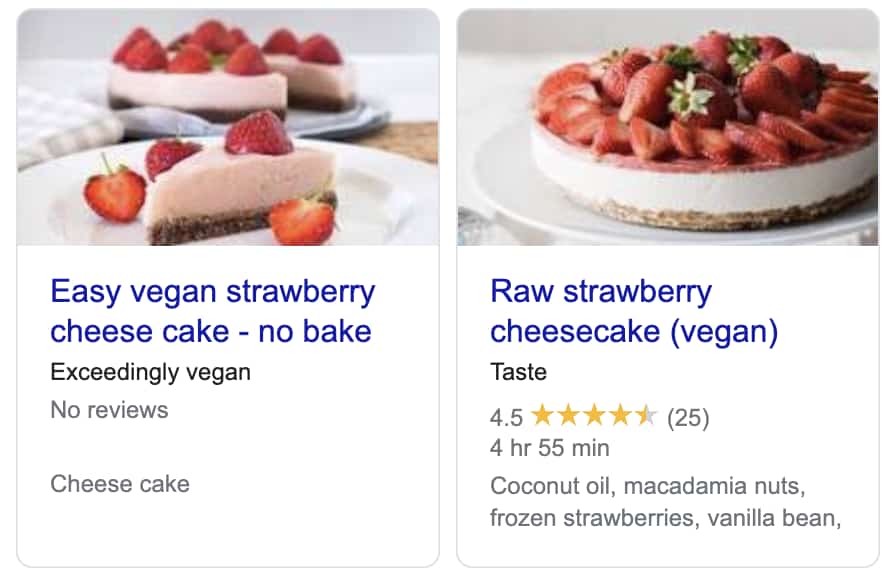
I would probably click on the second recipe, with 4.5 stars across 25 reviews instead of the first, which has no reviews.
Recipe reviews lend credibility to the recipe, and good aggregate reviews can boost your clickthrough rate. There are many plugins for WordPress that can add this functionality.
Cook up a recipe video
Google recommends adding a video to your recipe. Having one can land you in recipe video search results. Also, the video content can be organically found on YouTube or other search channels.
Some people like following a video instead of reading directions while they are trying out a new recipe. Embedding a video on your page will help those viewers stay on your site.
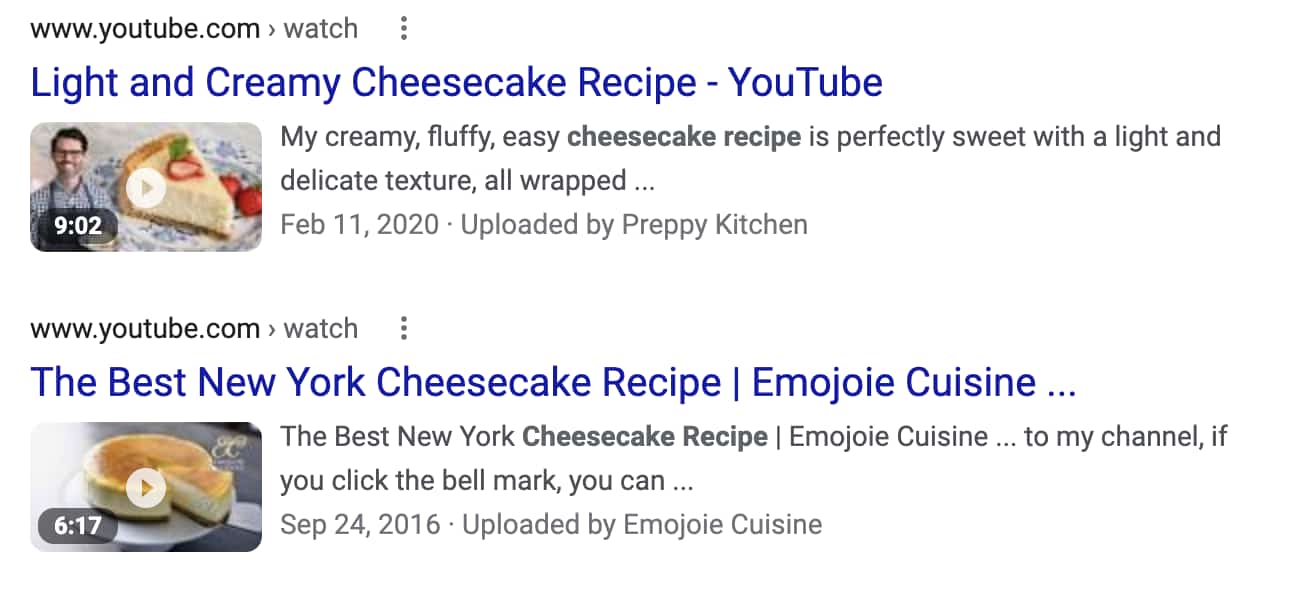
Machine Friendly Recipe Page Structure for SEO
This section covers how to ensure a machine-friendly page structure for recipe search engine optimization. To interpret and understand your recipe, crawlers use the content of headings as a potential outline, and inbound/outbound links to draw connections.
This section covers:
- Double-check your recipe’s H1 heading
- Ensure consistent heading hierarchy
- Manage your internal links for SEO
- Thoughtfully link externally
Double-check your recipe’s H1 heading
Your h1 heading is the important content tag on your page. Crawlers will almost always index this heading tag as a signal for the main topic of the page. To make this work for you, the main heading should:
- contain your exact target keywords
- placed before most other content
- the same as the start of the page title
- exist only once on a page
- have an appropriate length, that is, not too long
Ensure consistent heading hierarchy
The hierarchy of headings on your page is important for search engines to understand how the content of your page is laid out. Your headings should follow numerical order, meaning H1 should always come first, followed by H2s, and so forth.
Doing this consistently also helps your users navigate your content more easily. Also, Google may choose to feature a snippet of your headings. For example, if one of your H2 sections is “how to perfectly boil tortellini pasta”, your H3s maybe a series of steps.
Do not skip levels in headings, and keep the content coherent with the parent headings.
Manage your internal links for SEO
Internal links are important for search engines to not only crawl your site but also understand what keywords are relevant for the content you are linking to.
Crafting thoughtful anchor text for your internal links can increase traffic to your site’s content, as well as help crawlers reinforce the topic of linked pages.
For example, linking to a specific internal page with rich keywords from multiple pages can boost the ranking of the linked content. This is particularly true for long-tail queries.
SEO best practices for internal links:
- Cross-link similar content to reinforce page topics
- Link to indexes or recipe list pages to promote discoverability
- Have meaningful anchor text for your internal links
- Do not overlink the same internal links on a page
Thoughtfully link externally
Recipe outbound links to another site are not likely to adversely affect your search ranking, as long as you are organically linking out to reputable sources. It could even help you earn some credibility to your users and search engines.
Linking to reputable, non-broken links a handful of times can create a better user experience and potentially generate linkbacks.
SEO best practices for recipe outbound links:
- Make sure your external links are not broken.
- Do not over link any particular resource.
- Ensure outbound links are relevant to the content on your page.
- Setting external links to open in a new tab can help users stay on your page.
Create Search Engine Optimized Page Content
Page content is equally important as page structure for recipe SEO.
Your content should reinforce the topic keywords of your recipe, as well as keep viewers engaged. Also, adding lists, paragraphs, and optimizing your pictures keeps crawlers happy with easy to parse, fast content.
This section covers:
- Maximize targeted keyword coverage with rich content
- Increase readability and boost engagement for your viewers
- Make use of visual styles for SEO and usability
- Optimize your recipe pictures for SEO
Maximize targeted keyword coverage with thoughtful content
Maximizing target keyword coverage across all your assets and content will help your recipe SEO.
While it’s true crawlers understand the semantic context behind your recipe sections, centering on your target keywords helps your content stay focused and on-topic.
It can help to create an outline of the sections you want to deep dive into a particular ingredient, preparation step, or other aspects of your recipe.
Your targeted keywords for your recipe should appear exactly in the content of your page at least once. Also, each word from your target phrase should appear multiple times on your page, as well as each being a top-ranked word in your content by frequency.
Don’t overdo keywords or “keyword stuff” your content though - topic-focused food blogging will get you there naturally.
When someone searches for a recipe, Google may include a snippet from your recipe content with long-tail keyword search terms. Being aware of where and how your keywords show up creates a better search experience and potential higher click through rates.
Other places to include target keywords to boost recipe SEO:
- Page URL
- Image link URL
- Image alt text
- H2 headings
- Inbound link anchor text
Test if any of your content or assets are missing your target keywords.
Increase readability and boost engagement for your viewers
Recipes with fuller content are ranked higher in general compared to short recipes.
Detailed explanations of each step, ingredient choices, substitutions, optional adjustments, and backstory can all help fill out the content of your recipe.
A FAQ section for questions viewers may have would also be great for search engines to index answers to common questions.
Studies from Readable have shown that easy to read pages result in significantly higher engagement and lower bounce rates. Make your recipe as easy to read as possible, specifically raising the Flesch-Kincaid score. Try to use simpler words and shorter sentences.
Make use of visual styles for SEO and usability
Blocks of text might put off viewers when they are looking for answers or just the base recipe. Visually enhance your recipe by creating lists, paragraphs, and emphasizing important text so the user can scan for the information they need.
Lists help improve readability for humans as well as for search engines. Having lists on your page can help increase engagement and also might get you featured in a search snippet.
Strong or emphasized text helps users skim your content.
If your recipe offers a lot of media that takes a while to load, it’s also helpful for users to have a “jump to recipe” button or bookmark.
Optimize your recipe pictures for SEO
Images on your recipe page are extremely important for search engine optimization.
You must have at least one image to qualify for rich results on Google. In addition, images enable you to utilize social sharing platforms like Pinterest. Furthermore, images allow your recipes to be discovered from other organic channels, such as media or image searches.
Beautiful recipe pictures entice viewers to click on your recipe.
More and more recipes are incorporating pictures step by step. This helps users see the step by step process as well as crawlers index more image content. Google even allows step by step pictures in their rich data markup.
Make sure your recipe images are SEO friendly:
- Images are not too large and optimized for network traffic
- Image links are not broken or redirects
- Image alt text and URL links are appropriate, simple, and contain relevant keywords
- Defer loading of larger images can help your page performance, particularly on mobile
Tune-up Recipe Page Performance
Another increasingly important dimension for recipe search engine optimization is your page performance, or what Google calls Core Web Vitals.
This year, Google will be rolling out three performance metrics as factors in ranking sites and pages. The three dimensions measuring your page performance are loading time, interactivity, and visual stability.
Whereas most pages perform reasonably on desktop, many pages, especially media-heavy recipes suffer performance-wise on mobile.
Some of the most common causes for recipes are loading too many external scripts, non-deferred large images, and script execution that blocks the page from being ready.
Test out the search engine performance of your recipe, with 100+ checks for free. Google also offers a free PageSpeed insights service for you to gauge the performance of your page.
This section covers:

Recipe Page Loading Time
The first metric is loading time, or measured by Largest Contentful Paint (LCP). Google recommends that to provide a good user experience, this metric should be within 2.5 seconds of when the page first starts loading.
Google lists the most common causes for a slow loading time:
- Slow server response times
- Render-blocking JavaScript and CSS
- Slow resource load times
- Client-side rendering
The common ones we’ve seen for recipes include render-blocking JavaScript and large, undeferred, or unoptimized images. Try to minimize the number of scripts you have on your page, and defer loading media assets as much as possible.
Recipe Page Interactivity
The second metric is interactivity or measured by First Input Delay (FID). This is a gauge of how responsive your page is when the user tries to interact with it. Google recommends that to provide a good user experience, this metric should be less than 100 milliseconds.
The main cause of a high input delay or lag in interactivity is heavy JavaScript execution. There are several ways to alleviate slow responsiveness on web pages.
Recipe Page Visual Stability
The third metric is visual stability or measured by Cumulative Layout Shift (CLS). This is a gauge of how much your recipe page jumps, or how many elements on your page move unexpectedly after load. A bit more obscure of a measurement, Google recommends that pages should maintain a CLS of less than 0.1.
Google lists the most common causes for poor visual stability:
- Images without dimensions
- Ads, embeds, and iframes without dimensions
- Dynamically injected content
- Web Fonts causing FOIT/FOUT
- Actions waiting for a network response before updating DOM
For recipes, we've seen poor CLS scores for images that are loaded without preset dimensions, and ads or videos that load after the page has been loaded. These cause the page to jump a second or two after load, shifting the content on the page.
Adopt a Recipe WordPress Plugin
Adopting a plugin on WordPress can handle many aspects of recipe search engine optimization for you. Some of the major players in WordPress plugins for recipes include WP Tasty, WP Recipe Maker, WP Ultimate Recipe, and Cooked.
There have been many well thought out reviews for recipe WordPress plugins, so I’ll defer to the experts:
A detailed explanation of WordPress plugins, what they do, and a FAQ:
https://www.foodbloggersofcanada.com/choosing-the-wordpress-recipe-plugin-thats-right-for-you/
Recently updated with features and pricing for a comparison between the top 6 WordPress recipe plugins:
https://athemes.com/collections/best-recipe-plugins-for-wordpress/
A compilation of 15 different WordPress recipe plugins from Colorlib:
https://colorlib.com/wp/wordpress-recipe-plugins/